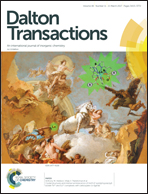Dielectric relaxation and anhydrous proton conduction in [C2H5NH3][Na0.5Fe0.5(HCOO)3] metal–organic frameworks†
Abstract
Metal–organic frameworks (MOFs), in which metal clusters are coupled by organic moieties, exhibit inherent porosity and crystallinity. Although these systems have been examined for vast potential applications, the elementary proton conduction in anhydrous MOFs still remains elusive. One of the approaches to deal with this problem is the utilization of protic organic molecules, to be accommodated in the porous framework. In this work we report the temperature-dependent crystal structure and proton conduction in [C2H5NH3][Na0.5Fe0.5(HCOO)3] metal–organic frameworks using X-ray diffraction and broadband dielectric spectroscopic techniques. The detailed analysis of the crystal structure reveals disorder of the terminal ethylene groups in the polar phase (space group Pn). The structural phase transition from Pn to P21/n at T ≈ 363 K involves the distortion of the metal formate framework and ordering of EtA+ cations due to the reduction of the cell volume. The dielectric data have been presented in the dynamic window of permittivity formalism to understand the ferroelectric phase transition. The relaxation times have been estimated from the Kramers–Kronig transformation of the dielectric permittivity. A Grotthuss type mechanism of the proton conduction is possible at low temperatures with the activation energy of 0.23 eV. This type of experimental observation is expected to provide new prospective on the fundamental aspect of elementary proton transfer in anhydrous MOFs.
![Graphical abstract: Dielectric relaxation and anhydrous proton conduction in [C2H5NH3][Na0.5Fe0.5(HCOO)3] metal–organic frameworks](/en/Image/Get?imageInfo.ImageType=GA&imageInfo.ImageIdentifier.ManuscriptID=C6DT04546D&imageInfo.ImageIdentifier.Year=2017)


 Please wait while we load your content...
Please wait while we load your content...